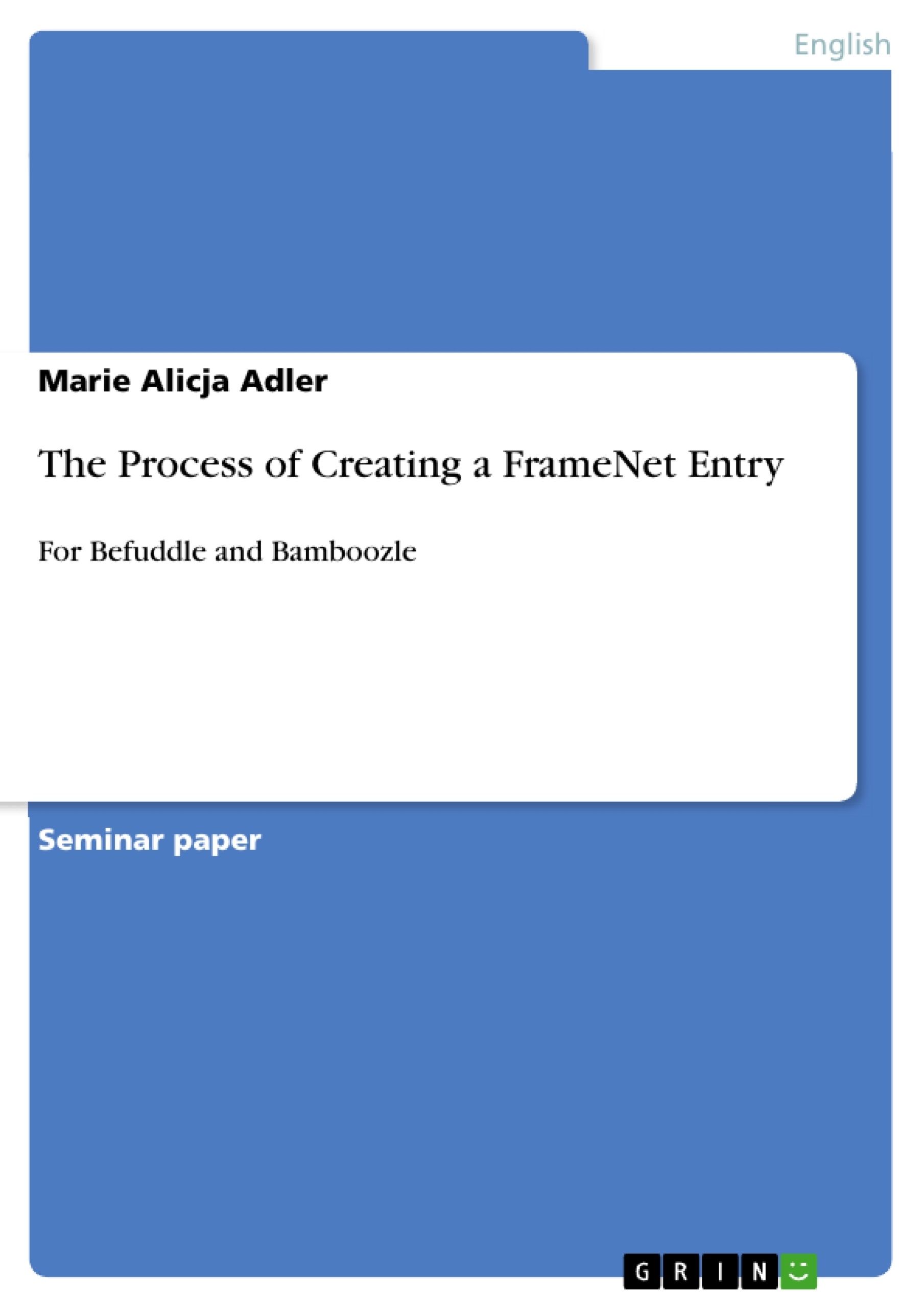With his theory of Frame Semantics, Charles J. Fillmore provided an utterly innovative way of approaching word meaning and conceptualization. FrameNet, the project developed in line of the new insights, gives out information on words that is often said to exceed that provided by traditional dictionaries. This term paper seeks to scrutinize this assumption by illustrating the working process by which entries for FrameNet are generated, using the example of the synonyms befuddle and bamboozle. Furthermore, it sets out to define the frames to which both Lexical Units belong. For this purpose, chapter 1 provides a theoretical introduc
and the design of FrameNet. Moreover, it contrasts FrameNet with other approaches to meaning. A corpus analysis for befuddle and bamboozle will be conducted typical use and the data will be analyzed in chapter 2. Chapter 3 presents befuddle and bamboozle in comparison and contrast. Finally, the frames that both lexical units have in common will be defined in chapter 4. The process is mainly based on the step-by-step description provided by Fillmore Lexicon. The Semantics of Risk & Atkins, 1992).
Inhaltsverzeichnis (Table of Contents)
- 0 INTRODUCTION
- 1 THEORETICAL FRAMEWORK
- 1.1 Frame Semantics
- 1.2 FrameNet and Other Approaches
- 2 CORPUS ANALYSIS FOR BEFUDDLE AND BAMBOOZLE
- 2.1 Analysis of the Data
- 2.1.1 Analysis of the Data for Befuddle
- 2.1.2 Analysis of the Data for Bamboozle
- 2.1 Analysis of the Data
- 3 BEFUDDLE AND BAMBOOZLE IN CONTRAST
- 4 THE FRAMES
- 4.1 The STIRRING_CONFUSION Frame
- 4.2 THE TRICKING FRAME
- 5 CONCLUSION
Zielsetzung und Themenschwerpunkte (Objectives and Key Themes)
This term paper aims to illustrate the process of creating entries for FrameNet, using the example of the synonyms befuddle and bamboozle. It also seeks to define the frames to which both lexical units belong. The paper investigates the relationship between word meaning and encyclopedic knowledge, focusing on the concept of frames and their application in understanding word meaning.
- Frame Semantics and its role in understanding word meaning
- The FrameNet project and its methodology for creating entries for individual words
- The frames associated with the words befuddle and bamboozle
- The application of corpus analysis in identifying the typical use and semantic nuances of words
- The relationship between semantic prosody and the use of words in context
Zusammenfassung der Kapitel (Chapter Summaries)
- Chapter 1 provides a theoretical introduction to Fillmore's theory of Frame Semantics and the design of FrameNet. It also contrasts FrameNet with other approaches to meaning, showcasing its unique approach to understanding word meaning.
- Chapter 2 details the process of corpus analysis for befuddle and bamboozle, exploring the typical use and semantic nuances of the two words. This chapter examines the collected data and analyzes its implications for understanding the frames associated with these words.
- Chapter 3 presents a comparative analysis of befuddle and bamboozle, highlighting their similarities and differences in terms of their meaning, usage, and associated frames.
- Chapter 4 defines the frames to which befuddle and bamboozle belong, analyzing the frame elements, their relationships, and the semantic relationships between the words and their frames.
Schlüsselwörter (Keywords)
The main keywords and focus topics of the text include Frame Semantics, FrameNet, corpus analysis, lexical units, frame elements, semantic prosody, befuddle, and bamboozle. The work explores the relationship between word meaning, conceptualization, and encyclopedic knowledge, focusing on the application of FrameNet in understanding the meaning of words and their use in context.
- Quote paper
- Marie Alicja Adler (Author), 2013, The Process of Creating a FrameNet Entry , Munich, GRIN Verlag, https://www.grin.com/document/229949



